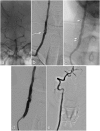Neuroform Atlas stent in treatment of iatrogenic dissections of extracranial internal carotid and vertebral arteries: a single-centre experience
- PMID: 30803334
- PMCID: PMC6607618
- DOI: 10.1177/1591019919830215
Neuroform Atlas stent in treatment of iatrogenic dissections of extracranial internal carotid and vertebral arteries: a single-centre experience
Abstract
Aim of the study: To present our experience in the treatment of iatrogenic dissections of extracranial internal carotid and vertebral arteries with the Neuroform Atlas stent.
Materials and methods: Between January 2017 and February 2018 we treated iatrogenic dissections of three internal carotid arteries and three vertebral arteries. These iatrogenic dissections occurred during the endovascular treatment of ruptured and unruptured intracranial aneurysms. The indication for stenting was haemodynamically significant, flow-limiting dissection with threatening flow arrest. In all six cases, the dissections were treated by placement of Neuroform Atlas stents in the dissected segments of internal carotid or vertebral arteries. Deployment of the stent was followed by the usual dual antiplatelet regimen.
Results: Single or multiple Neuroform Atlas stents were deployed without any technical difficulties, and blood flow was restored immediately after placement of the stents in all six cases. Midterm follow-up (6-8 months) showed complete reconstruction of the shape and lumen of all treated arteries, with negligible intimal hyperplasia.
Conclusion: Our results indicate that a favourable outcome can be achieved by treating iatrogenic dissections of extracranial internal carotid and vertebral arteries with the Neuroform Atlas stent.
Keywords: Atlas; iatrogenic dissection; treatment.
Figures




Similar articles
-
Endovascular treatment of distal cervical and intracranial dissections with the neuroform stent.Neurosurgery. 2008 Mar;62(3):636-46; discussion 636-46. doi: 10.1227/01.NEU.0000311350.25281.6B. Neurosurgery. 2008. PMID: 18301346
-
Treatment of extracranial and intracranial aneurysms and arteriovenous fistulae using stent grafts.Neurosurgery. 2004 Sep;55(3):631-8; discussion 638-9. doi: 10.1227/01.neu.0000134455.02947.1f. Neurosurgery. 2004. PMID: 15335430
-
Spontaneous bilateral internal carotid and vertebral artery dissections with dominant-hemisphere circulation maintained by external carotid artery-ophthalmic artery anastomoses.Neurosurg Focus. 2019 Feb 1;46(2):E6. doi: 10.3171/2018.11.FOCUS18443. Neurosurg Focus. 2019. PMID: 30717066
-
Endovascular management of internal carotid artery injuries secondary to endonasal surgery: case series and review of the literature.J Neurosurg. 2016 Nov;125(5):1256-1276. doi: 10.3171/2015.6.JNS142483. Epub 2016 Jan 15. J Neurosurg. 2016. PMID: 26771847 Review.
-
Endovascular repair of extracranial carotid artery dissection: current status and level of evidence.J Vasc Interv Radiol. 2008 Dec;19(12):1693-8. doi: 10.1016/j.jvir.2008.08.025. Epub 2008 Oct 8. J Vasc Interv Radiol. 2008. PMID: 18845451 Review.
Cited by
-
Delayed Iatrogenic Dissection Caused by a Carotid Stent: A Case Report.NMC Case Rep J. 2021 Jun 12;8(1):241-245. doi: 10.2176/nmccrj.cr.2020-0258. eCollection 2021. NMC Case Rep J. 2021. PMID: 35079470 Free PMC article.
-
Comparative meta-analysis of endovascular strategies for intracranial dissecting aneurysms: Flow diverters versus stents with or without coiling.Interv Neuroradiol. 2024 Jun 14:15910199241262070. doi: 10.1177/15910199241262070. Online ahead of print. Interv Neuroradiol. 2024. PMID: 38873695 Free PMC article. Review.
-
Use of flow-diverting stents in the treatment of ruptured intracranial artery dissections.Surg Neurol Int. 2025 May 9;16:172. doi: 10.25259/SNI_1062_2024. eCollection 2025. Surg Neurol Int. 2025. PMID: 40469354 Free PMC article.
-
Successful Management of Intraprocedural Arterial Dissection During Carotid Artery Stenting With an Overlapping CASPER Rx Stent for Tortuous Vessel: A Case Report.Cureus. 2024 Nov 26;16(11):e74475. doi: 10.7759/cureus.74475. eCollection 2024 Nov. Cureus. 2024. PMID: 39726489 Free PMC article.
References
-
- Kaufmann TJ, Huston J, Mandrekar JN, et al. Complications of diagnostic cerebral angiography: evaluation of 19,826 consecutive patients. Radiology 2007; 243: 812–819. - PubMed
-
- Fifi JT, Meyers PM, Lavine SD, et al. Complications of modern diagnostic cerebral angiography in an academic medical center. J Vasc Interv Radiol 2009; 20: 442–447. - PubMed
-
- Pham MH, Rahme RJ, Arnaout O, et al. Endovascular stenting of extracranial carotid and vertebral artery dissections: a systematic review of the literature. Neurosurgery 2011; 68: 856–866. - PubMed
-
- Groves AP, Kansagra AP, Cross DT, III, et al. Acute management and outcomes of iatrogenic dissections during cerebral angiography. J Neurointervent Surg 2017; 9: 499–501. - PubMed
MeSH terms
LinkOut - more resources
Full Text Sources
Medical
Research Materials

